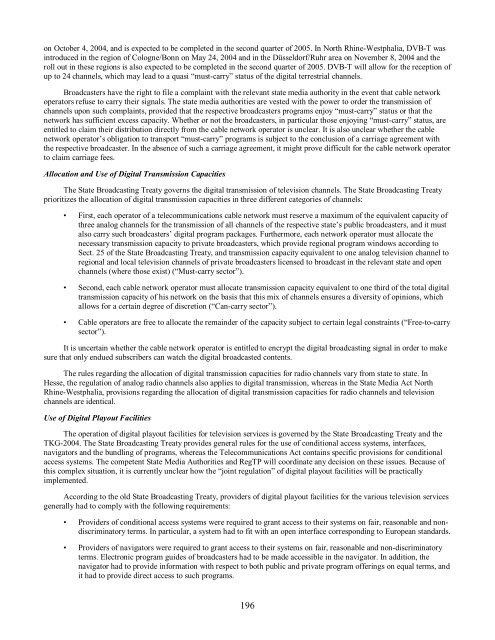iesy Repository GmbH - Irish Stock Exchange
iesy Repository GmbH - Irish Stock Exchange
iesy Repository GmbH - Irish Stock Exchange
You also want an ePaper? Increase the reach of your titles
YUMPU automatically turns print PDFs into web optimized ePapers that Google loves.
on October 4, 2004, and is expected to be completed in the second quarter of 2005. In North Rhine-Westphalia, DVB-T was<br />
introduced in the region of Cologne/Bonn on May 24, 2004 and in the Düsseldorf/Ruhr area on November 8, 2004 and the<br />
roll out in these regions is also expected to be completed in the second quarter of 2005. DVB-T will allow for the reception of<br />
up to 24 channels, which may lead to a quasi “must-carry” status of the digital terrestrial channels.<br />
Broadcasters have the right to file a complaint with the relevant state media authority in the event that cable network<br />
operators refuse to carry their signals. The state media authorities are vested with the power to order the transmission of<br />
channels upon such complaints, provided that the respective broadcasters programs enjoy “must-carry” status or that the<br />
network has sufficient excess capacity. Whether or not the broadcasters, in particular those enjoying “must-carry” status, are<br />
entitled to claim their distribution directly from the cable network operator is unclear. It is also unclear whether the cable<br />
network operator’s obligation to transport “must-carry” programs is subject to the conclusion of a carriage agreement with<br />
the respective broadcaster. In the absence of such a carriage agreement, it might prove difficult for the cable network operator<br />
to claim carriage fees.<br />
Allocation and Use of Digital Transmission Capacities<br />
The State Broadcasting Treaty governs the digital transmission of television channels. The State Broadcasting Treaty<br />
prioritizes the allocation of digital transmission capacities in three different categories of channels:<br />
• First, each operator of a telecommunications cable network must reserve a maximum of the equivalent capacity of<br />
three analog channels for the transmission of all channels of the respective state’s public broadcasters, and it must<br />
also carry such broadcasters’ digital program packages. Furthermore, each network operator must allocate the<br />
necessary transmission capacity to private broadcasters, which provide regional program windows according to<br />
Sect. 25 of the State Broadcasting Treaty, and transmission capacity equivalent to one analog television channel to<br />
regional and local television channels of private broadcasters licensed to broadcast in the relevant state and open<br />
channels (where those exist) (“Must-carry sector”).<br />
• Second, each cable network operator must allocate transmission capacity equivalent to one third of the total digital<br />
transmission capacity of his network on the basis that this mix of channels ensures a diversity of opinions, which<br />
allows for a certain degree of discretion (“Can-carry sector”).<br />
• Cable operators are free to allocate the remainder of the capacity subject to certain legal constraints (“Free-to-carry<br />
sector”).<br />
It is uncertain whether the cable network operator is entitled to encrypt the digital broadcasting signal in order to make<br />
sure that only endued subscribers can watch the digital broadcasted contents.<br />
The rules regarding the allocation of digital transmission capacities for radio channels vary from state to state. In<br />
Hesse, the regulation of analog radio channels also applies to digital transmission, whereas in the State Media Act North<br />
Rhine-Westphalia, provisions regarding the allocation of digital transmission capacities for radio channels and television<br />
channels are identical.<br />
Use of Digital Playout Facilities<br />
The operation of digital playout facilities for television services is governed by the State Broadcasting Treaty and the<br />
TKG-2004. The State Broadcasting Treaty provides general rules for the use of conditional access systems, interfaces,<br />
navigators and the bundling of programs, whereas the Telecommunications Act contains specific provisions for conditional<br />
access systems. The competent State Media Authorities and RegTP will coordinate any decision on these issues. Because of<br />
this complex situation, it is currently unclear how the “joint regulation” of digital playout facilities will be practically<br />
implemented.<br />
According to the old State Broadcasting Treaty, providers of digital playout facilities for the various television services<br />
generally had to comply with the following requirements:<br />
• Providers of conditional access systems were required to grant access to their systems on fair, reasonable and nondiscriminatory<br />
terms. In particular, a system had to fit with an open interface corresponding to European standards.<br />
• Providers of navigators were required to grant access to their systems on fair, reasonable and non-discriminatory<br />
terms. Electronic program guides of broadcasters had to be made accessible in the navigator. In addition, the<br />
navigator had to provide information with respect to both public and private program offerings on equal terms, and<br />
it had to provide direct access to such programs.<br />
196

















